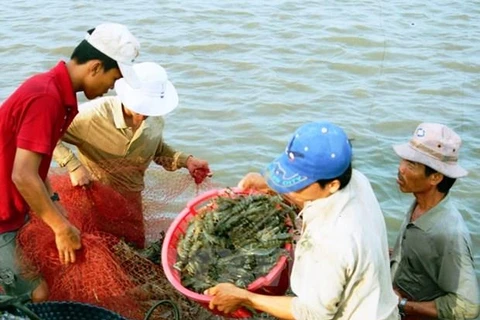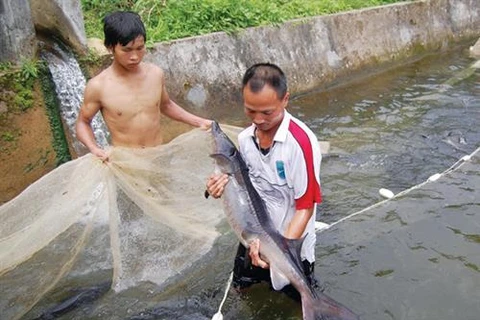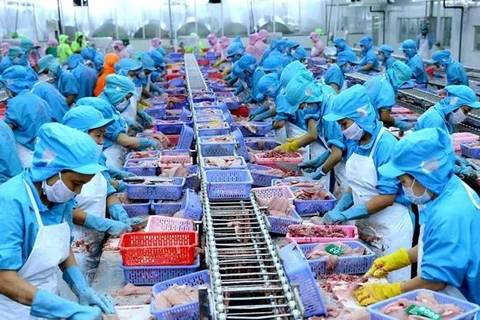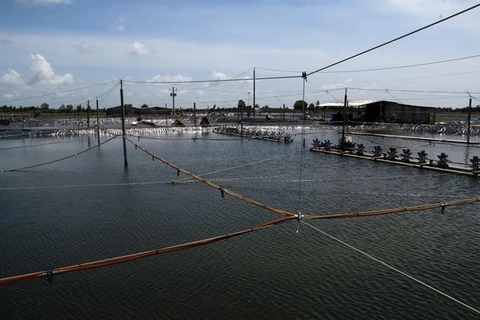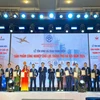Hanoi (VNS/VNA) - Vietnam has huge potential for ocean aquaculture but the lack of a proper development plan, preferential policies and application of high technology has hindered its development.
The country has great potential for mariculture thanks to its long coastline, relatively large Exclusive Economic Zone (EEZ) and diverse water bodies embracing lagoons and bays, according to experts.
Ocean aquaculture has become a global trend due to its huge potential and increasing demand for seafood.
The world population keeps growing, leading to increasing consumer demand for seafood, according to the Food and Agriculture Organisation of the United Nations (FAO).
An estimated additional 19 million tonnes of seafood are needed by 2030 worldwide in comparison with 2015. By 2050, the world would need an amount of animal proteins that is 1.7 times higher than today, according to the FAO.
Chairman of the Vietnam Seaculture Association Nguyen Huu Dung said mariculture is assessed to be more efficient in terms of economy and environment than raising animals on land. Ocean aquaculture has a lower Feed Conversion Ratio (FCR) and inflicts less harm on the environment, he said.
Cultivation of seaweed at sea can help feed the growing world population as proteins from seaweed can be utilised as raw materials for various products, according to researchers of the Plant Research International. Proteins from seaweed can be used as food for both humans and animals.
The growth of seaweed at sea can reach 400kg of protein per hectare per year while plants can only get 16kg of proteins per hectares per year, Dung said.
Also, seaweed growth does not need fertilisers and plant protection chemicals while helping to absorb environmental pollutants in the atmosphere and at sea, he said.
With a coastline of over 3,260km and numerous islands and bays, the country ranks as the world’s fourth-largest producer of seafood from aquaculture. In 2018, seafood export turnover surpassed 9 billion USD.
The national strategy for sustainable mariculture development by 2030 states that Vietnam has great potential for mariculture, particularly in raising maritime varieties with high economic values such as plaice, grouper, tuna, oysters for pearls and seaweed.
There are currently around 50,000 households living along coastal areas engaged in marine aquaculture but most of them are of a small-scale with out-dated technology, low economic efficiency, unsustainability and cause environmental pollution in some areas. They also chiefly operate near-shore to avoid storms, rough seas and other extreme weather while much potential remains for offshore marine aquaculture.
Experts also warned that Vietnam has huge potential for marine aquaculture but challenges remain due to the lack of national marine aquaculture development plans and preferential policies to draw investment from the business community.
Weak State management, out-dated technology and environmental pollution risks are also challenges facing the industry.
There is also a shortage of maritime production chains from marine aquaculture farms to businesses providing food, breeding varieties and processing and distribution services.
To help develop mariculture sustainably, experts from the Vietnam Mariculture Association said it is necessary to build related mechanisms, policies and infrastructure to encourage businesses to join the industry.
Applying modern technology in mariculture as well as in preserving, transporting and processing seafood would also help to increase the products’ economic value.
Human resources training and international cooperation promotion are also needed.
The association has proposed the Government to build a national industrial mariculture development target programme by 2030 with a policy framework to encourage the participation of more businesses in mariculture.
Under the strategy for sustainable mariculture development, Vietnam targets to reach 600,000 tonnes of marine farmed fish, 100,000 tonnes of seaweed and 100,000 tonnes of molluscs. Seafood export turnover is expected to reach 20-25 billion USD by 2030.-VNS/VNA
The country has great potential for mariculture thanks to its long coastline, relatively large Exclusive Economic Zone (EEZ) and diverse water bodies embracing lagoons and bays, according to experts.
Ocean aquaculture has become a global trend due to its huge potential and increasing demand for seafood.
The world population keeps growing, leading to increasing consumer demand for seafood, according to the Food and Agriculture Organisation of the United Nations (FAO).
An estimated additional 19 million tonnes of seafood are needed by 2030 worldwide in comparison with 2015. By 2050, the world would need an amount of animal proteins that is 1.7 times higher than today, according to the FAO.
Chairman of the Vietnam Seaculture Association Nguyen Huu Dung said mariculture is assessed to be more efficient in terms of economy and environment than raising animals on land. Ocean aquaculture has a lower Feed Conversion Ratio (FCR) and inflicts less harm on the environment, he said.
Cultivation of seaweed at sea can help feed the growing world population as proteins from seaweed can be utilised as raw materials for various products, according to researchers of the Plant Research International. Proteins from seaweed can be used as food for both humans and animals.
The growth of seaweed at sea can reach 400kg of protein per hectare per year while plants can only get 16kg of proteins per hectares per year, Dung said.
Also, seaweed growth does not need fertilisers and plant protection chemicals while helping to absorb environmental pollutants in the atmosphere and at sea, he said.
With a coastline of over 3,260km and numerous islands and bays, the country ranks as the world’s fourth-largest producer of seafood from aquaculture. In 2018, seafood export turnover surpassed 9 billion USD.
The national strategy for sustainable mariculture development by 2030 states that Vietnam has great potential for mariculture, particularly in raising maritime varieties with high economic values such as plaice, grouper, tuna, oysters for pearls and seaweed.
There are currently around 50,000 households living along coastal areas engaged in marine aquaculture but most of them are of a small-scale with out-dated technology, low economic efficiency, unsustainability and cause environmental pollution in some areas. They also chiefly operate near-shore to avoid storms, rough seas and other extreme weather while much potential remains for offshore marine aquaculture.
Experts also warned that Vietnam has huge potential for marine aquaculture but challenges remain due to the lack of national marine aquaculture development plans and preferential policies to draw investment from the business community.
Weak State management, out-dated technology and environmental pollution risks are also challenges facing the industry.
There is also a shortage of maritime production chains from marine aquaculture farms to businesses providing food, breeding varieties and processing and distribution services.
To help develop mariculture sustainably, experts from the Vietnam Mariculture Association said it is necessary to build related mechanisms, policies and infrastructure to encourage businesses to join the industry.
Applying modern technology in mariculture as well as in preserving, transporting and processing seafood would also help to increase the products’ economic value.
Human resources training and international cooperation promotion are also needed.
The association has proposed the Government to build a national industrial mariculture development target programme by 2030 with a policy framework to encourage the participation of more businesses in mariculture.
Under the strategy for sustainable mariculture development, Vietnam targets to reach 600,000 tonnes of marine farmed fish, 100,000 tonnes of seaweed and 100,000 tonnes of molluscs. Seafood export turnover is expected to reach 20-25 billion USD by 2030.-VNS/VNA
VNA

